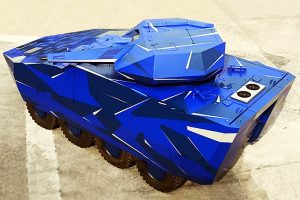
FFG’s Genesis hybrid technology demonstrator: out of the blue!
Located in the northernmost part of Germany, along the border with Denmark, FFG Flensburger Fahrzeugbau GmbH is active in the armoured vehicles field, upgrading existing ones, designing own projects as well as modules for existing vehicles.
At Eurosatory 2022 the Schleswig-Holstein based company unveiled an 8×8 technology demonstrator based on hybrid propulsion, the Genesis, which development started around five years ago, all carried out on company funding.
FFG underlines that this vehicle is not targeted at a customer, but it is solely developed to allow the company to acquire experience and know how on what might well become in the near future a standard in military propulsion, and the blue paint adopted was there to reinforce this concept.
The Genesis adopts serial hybrid propulsion, which means that wheels are moved by electric motors powered by batteries, a diesel generator ensuring the reload of the latter, a recuperation system also helping to get back energy when braking. The advantages of a hybrid solution are well-known, maximum torque always available, a lot of energy on board that allows powering energy-hungry subsystems, the capacity of extended silent watch, and also reduced fuel consumption. As far as modularity, the Genesis adopts a mission module concept similar to that of the Boxer, which allows quick interchangeability. With a maximum combat weight of 40 tonnes, the Genesis carrier weighs 25 tonnes, the 15 tonnes payload allowing a considerable flexibility in terms of modules. At Eurosatory the Genesis was fitted with a 10 tonnes armoured personnel carrier module hosting 10 dismounts and one gunner, the latter responsible for managing the 30 mm unmanned turret. With the module installed the vehicle height was 3.47 meters, the carrier being 2.4 meters high, the Genesis being 8.25 meters long and 3.2 meters wide.
The FFG demonstrator has a 171 kW electric motor per axle with reduction gear, located within the hull, all electric components being located under the floor, while batteries as well as the Deutz 6-litres 200 kW generator are installed forward of the front bulkhead. The battery pack is made of Lithium-Ion elements, however these were to be replaced soon after the exhibition with batteries based on the same chemistry but with higher power density and capable to provide a higher voltage, this shifting form 640 V to 800 V. The hybrid configuration allows the Genesis to provide up to 70 kW to subsystems installed on board, which can be sufficient for direct energy weapons, or to export it for external use, such as powering up a camp.
Suspensions are of the swing arms type with torsion bars. No axle is steering; FFG considers that current 8×8 turning diameter is a problem when moving into urban areas, especially in small cities, therefore it adopted a skid-steering solution, steering being ensured by differential rotation speed on the eight wheels. Skid-steering generates of course a higher consumption on pneumatics, but on the other hand it keeps mechanics simple; coupled to the lack of mechanical transmission due to the hybrid architecture, this ensures maximum design freedom, while also allowing to spare some weight.
The Genesis has a drive-by-wire system, all vehicle’s control software being developed in-house by FFG, which ensures electronic drive management of each motor with individual speed and torque control for acceleration, deceleration and steering. The drive-by-wire solution also allows easily transforming the vehicle in a tele-operated or autonomously driven platform, something that might be of use in specific tactical situations to keep soldiers away from risk. All key functions are monitored via three multifunctional touch displays and controlled by the carrier two-man crew made of a driver and a commander, the former having a direct view of the road thanks to an armoured windscreen.
The propulsion solution adopted provides considerable redundancy; should one or two motors fail, the remaining are able to ensure mobility, albeit in degraded mode. It also allows a further level of modularity; propulsion modules can be easily adopted to build 6×6 or 4×4 platforms, generating a family of vehicles. As for the 8×8 family, FFG proposes a number of modules beside the APC seen at Eurosatory, such as command post, reconnaissance, NBC detection, recovery (the company developed the recovery module for the Boxer), medical evacuation, mortar carrier, and considering the payload also a howitzer module.
Coming to performances, the nominal drive power of 1,368 kW (1,835 hp) provides a power-to-weight ratio of 34.2 kW/t (45.88 hp/t), maximum torque being 15,622 Nm per wheel; although a direct comparison between electric and diesel propulsion is difficult to be made, this ratio considerably exceeds that of even the most powerful IFVs currently in service. According to specifications, the Genesis can reach a maximum speed of 100 km/h, climb a 60% slope and travel on a 30% side slope. The range in all-electric mode, therefore with the diesel engine shut down to minimise acoustic as well as thermal signatures, is of 150 km at 40 km/h speed, while with the support of the diesel to recharge batteries it goes up to 600 km at 60 km/h. EDR On-Line understood that the vehicle has already be submitted to static tests, the whole propulsion systems working with the vehicle lifted on jacks. A driving test campaign should start soon to verify the aforementioned data, which were obtained based on theoretical calculations.
FFG is looking with interest at the evolution of the German Army armoured component, its technology being proposed for example for the replacement of today Fennek reconnaissance vehicle as part of the future Main Ground Combat System.
Photos courtesy FFG and P. Valpolini







